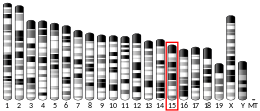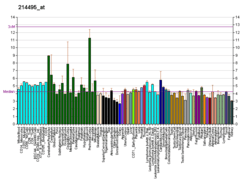CACNG2
Calcium channel, voltage-dependent, gamma subunit 2, also known as CACNG2 or stargazin is a protein that in humans is encoded by the CACNG2 gene.[5]
Function
L-type calcium channels are composed of five subunits. The protein encoded by this gene represents one of these subunits, gamma, and is one of several gamma subunit proteins. It is an integral membrane protein that is thought to stabilize the calcium channel in an inactive (closed) state. This protein is similar to the mouse stargazin protein, mutations in which having been associated with absence seizures, also known as petit-mal or spike-wave seizures. This gene is a member of the neuronal calcium channel gamma subunit gene subfamily of the PMP-22/EMP/MP20 family.[5]
Stargazin is involved in the transportation of AMPA receptors to the synaptic membrane, and the regulation of their receptor rate constants — via its extracellular domain — once it is there. As it is highly expressed throughout the cerebral cortex, it is likely to have an important role in learning within these areas, due to the importance of AMPA receptors in LTP.
Interactions
CACNG2 has been shown to interact with GRIA4,[7] DLG4,[7][8] and MAGI2.[9]
See also
- Voltage-dependent calcium channel
References
- GRCh38: Ensembl release 89: ENSG00000166862 - Ensembl, May 2017
- GRCm38: Ensembl release 89: ENSMUSG00000019146 - Ensembl, May 2017
- "Human PubMed Reference:". National Center for Biotechnology Information, U.S. National Library of Medicine.
- "Mouse PubMed Reference:". National Center for Biotechnology Information, U.S. National Library of Medicine.
- "Entrez Gene: CACNG2 calcium channel, voltage-dependent, gamma subunit 2".
- Brandler WM, Antaki D, Gujral M, Noor A, Rosanio G, Chapman TR, et al. (24 March 2016). "Frequency and Complexity of De Novo Structural Mutation in Autism". The American Journal of Human Genetics. 98 (4): 1–13. doi:10.1016/j.ajhg.2016.02.018. PMC 4833290. PMID 27018473.
- Chen L, Chetkovich DM, Petralia RS, Sweeney NT, Kawasaki Y, Wenthold RJ, Bredt DS, Nicoll RA (2000). "Stargazin regulates synaptic targeting of AMPA receptors by two distinct mechanisms". Nature. 408 (6815): 936–43. doi:10.1038/35050030. PMID 11140673.
- Choi J, Ko J, Park E, Lee JR, Yoon J, Lim S, Kim E (Apr 2002). "Phosphorylation of stargazin by protein kinase A regulates its interaction with PSD-95". The Journal of Biological Chemistry. 277 (14): 12359–63. doi:10.1074/jbc.M200528200. PMID 11805122.
- Deng F, Price MG, Davis CF, Mori M, Burgess DL (Jul 2006). "Stargazin and other transmembrane AMPA receptor regulating proteins interact with synaptic scaffolding protein MAGI-2 in brain". The Journal of Neuroscience. 26 (30): 7875–84. doi:10.1523/JNEUROSCI.1851-06.2006. PMID 16870733.
Further reading
- Powers PA, Liu S, Hogan K, Gregg RG (May 1993). "Molecular characterization of the gene encoding the gamma subunit of the human skeletal muscle 1,4-dihydropyridine-sensitive Ca2+ channel (CACNLG), cDNA sequence, gene structure, and chromosomal location". The Journal of Biological Chemistry. 268 (13): 9275–9. PMID 8387489.
- Black JL, Lennon VA (Apr 1999). "Identification and cloning of putative human neuronal voltage-gated calcium channel gamma-2 and gamma-3 subunits: neurologic implications". Mayo Clinic Proceedings. 74 (4): 357–61. doi:10.4065/74.4.357. PMID 10221464.
- Burgess DL, Matsuura T, Ashizawa T, Noebels JL (Jan 2000). "Genetic localization of the Ca2+ channel gene CACNG2 near SCA10 on chromosome 22q13". Epilepsia. 41 (1): 24–7. doi:10.1111/j.1528-1157.2000.tb01500.x. PMID 10643919.
- Chen L, Chetkovich DM, Petralia RS, Sweeney NT, Kawasaki Y, Wenthold RJ, Bredt DS, Nicoll RA (2001). "Stargazin regulates synaptic targeting of AMPA receptors by two distinct mechanisms". Nature. 408 (6815): 936–43. doi:10.1038/35050030. PMID 11140673.
- Burgess DL, Gefrides LA, Foreman PJ, Noebels JL (Feb 2001). "A cluster of three novel Ca2+ channel gamma subunit genes on chromosome 19q13.4: evolution and expression profile of the gamma subunit gene family". Genomics. 71 (3): 339–50. doi:10.1006/geno.2000.6440. PMID 11170751.
- Choi J, Ko J, Park E, Lee JR, Yoon J, Lim S, Kim E (Apr 2002). "Phosphorylation of stargazin by protein kinase A regulates its interaction with PSD-95". The Journal of Biological Chemistry. 277 (14): 12359–63. doi:10.1074/jbc.M200528200. PMID 11805122.
- Schnell E, Sizemore M, Karimzadegan S, Chen L, Bredt DS, Nicoll RA (Oct 2002). "Direct interactions between PSD-95 and stargazin control synaptic AMPA receptor number". Proceedings of the National Academy of Sciences of the United States of America. 99 (21): 13902–7. doi:10.1073/pnas.172511199. PMC 129795. PMID 12359873.
- Moss FJ, Dolphin AC, Clare JJ (Sep 2003). "Human neuronal stargazin-like proteins, gamma2, gamma3 and gamma4; an investigation of their specific localization in human brain and their influence on CaV2.1 voltage-dependent calcium channels expressed in Xenopus oocytes". BMC Neuroscience. 4: 23. doi:10.1186/1471-2202-4-23. PMC 270087. PMID 14505496.
- Tomita S, Fukata M, Nicoll RA, Bredt DS (Mar 2004). "Dynamic interaction of stargazin-like TARPs with cycling AMPA receptors at synapses". Science. 303 (5663): 1508–11. doi:10.1126/science.1090262. PMID 15001777.
- Collins JE, Wright CL, Edwards CA, Davis MP, Grinham JA, Cole CG, Goward ME, Aguado B, Mallya M, Mokrab Y, Huckle EJ, Beare DM, Dunham I (2005). "A genome annotation-driven approach to cloning the human ORFeome". Genome Biology. 5 (10): R84. doi:10.1186/gb-2004-5-10-r84. PMC 545604. PMID 15461802.
- Yamazaki M, Ohno-Shosaku T, Fukaya M, Kano M, Watanabe M, Sakimura K (Dec 2004). "A novel action of stargazin as an enhancer of AMPA receptor activity". Neuroscience Research. 50 (4): 369–74. doi:10.1016/j.neures.2004.10.002. PMID 15567474.
- Priel A, Kolleker A, Ayalon G, Gillor M, Osten P, Stern-Bach Y (Mar 2005). "Stargazin reduces desensitization and slows deactivation of the AMPA-type glutamate receptors". The Journal of Neuroscience. 25 (10): 2682–6. doi:10.1523/JNEUROSCI.4834-04.2005. PMID 15758178.
- Stiffler MA, Grantcharova VP, Sevecka M, MacBeath G (May 2006). "Uncovering quantitative protein interaction networks for mouse PDZ domains using protein microarrays". Journal of the American Chemical Society. 128 (17): 5913–22. doi:10.1021/ja060943h. PMC 2533859. PMID 16637659.
- Bedoukian MA, Weeks AM, Partin KM (Aug 2006). "Different domains of the AMPA receptor direct stargazin-mediated trafficking and stargazin-mediated modulation of kinetics". The Journal of Biological Chemistry. 281 (33): 23908–21. doi:10.1074/jbc.M600679200. PMID 16793768.
- Körber C, Werner M, Hoffmann J, Sager C, Tietze M, Schmid SM, Kott S, Hollmann M (Jun 2007). "Stargazin interaction with alpha-amino-3-hydroxy-5-methyl-4-isoxazole propionate (AMPA) receptors is critically dependent on the amino acid at the narrow constriction of the ion channel". The Journal of Biological Chemistry. 282 (26): 18758–66. doi:10.1074/jbc.M611182200. PMID 17483093.
External links
- CACNG2+protein,+human at the US National Library of Medicine Medical Subject Headings (MeSH)
- CACNG2 human gene location in the UCSC Genome Browser.
- CACNG2 human gene details in the UCSC Genome Browser.
This article incorporates text from the United States National Library of Medicine, which is in the public domain.




